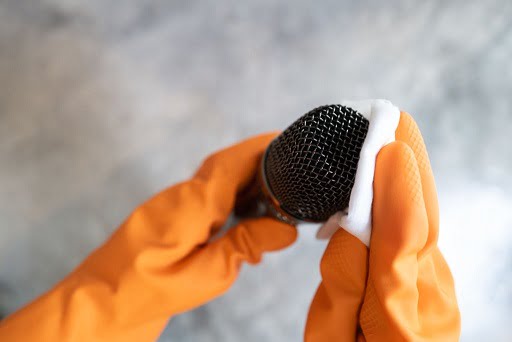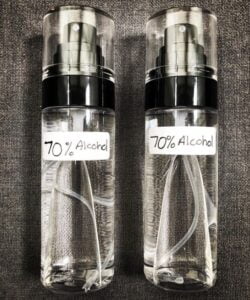If you’re a singer, then you know the importance of having a clean microphone. Not only does it make your voice sound better, but it also prevents bacteria from building up and causing infection.
In the Post Covid-19 world, microphone Hygiene is an essential factor for singers; moreover, it is often handled by more than one person, so the question that came to our mind is how you all sanitize your microphones between uses?
Some people argue that simply using a sanitized cloth is enough to clean the microphone, while others disagree and say that you need to use a disinfectant spray in order to kill any bacteria that might be present.
So, we took to the internet to find out what experts have to say about this topic. We have gathered all of the information that we could find and summarized it for you all in one place. So, without further ado, let’s get started!
Microphone Cleaning – General Tips!

Before we get into the nitty-gritty of how to clean your microphone, there are some general tips that you should keep in mind:
1. Use a dedicated microphone
This one is pretty self-explanatory – if you’re using a shared microphone, then there’s a higher chance of bacteria being transferred from one person to another. So, it’s best to use a dedicated microphone that is only used by one person.
2. Avoid using your hands
Your hands are one of the dirtiest parts of your body and they’re covered in bacteria. So, it’s best to avoid touching your microphone with your hands as much as possible. If you do have to touch it, make sure that you wash your hands thoroughly beforehand.
3. Store your microphone properly
When you’re not using your microphone, make sure that you store it in a clean and dry place. This will help to prevent the growth of bacteria and mold.
4. Clean your microphone regularly
It’s important to clean your microphone on a regular basis, even if you’re the only one using it. This will help to prevent the build-up of dirt and grime, which can eventually lead to problems.
5. Use a disposable microphone covers
If you’re using a shared microphone, then it’s a good idea to use disposable microphone covers. This will help to protect you from bacteria and other contaminants. Plus, they are pretty inexpensive and easy to find.
You can get them at most music stores or online for as low as $10 for a pack of 100.
6. Use “Lysol” type sprays
If you’re going to use a spray to clean your microphone, then make sure that it’s a “Lysol” type spray. These sprays are designed to kill virus and bacteria and they’re pretty effective at doing so.
They should be lightly sprayed and not drenched on the microphone as this could damage the electronics.


Protect Mic from viruses with Plastic Bags
The benefit of using plastic bags is that they act as a physical barrier between you and the microphone, protecting you from any bacteria or viruses that might be present on the surface of the microphone
Plus, plastic bags are cheap and easy to find, so there’s no excuse not to use them!
This simple hack will go a long way in keeping you safe and healthy, so be sure to give it a try the next time you’re using a microphone.
These covers are ideal for all types of microphones including lavalier, headset, and even wireless microphones.
You can even make your own covers out of plastic bags if you’re feeling extra DIY-inclined!

Sanitize Your Microphone Using the Bin System
If you want a professional-level setup you can use the bin system to sanitize your microphones.
In the Bin System, singers take the microphone from the “Clean” bin and put it in the “Used” bin after their performance.
You will need two bins (one for clean and one for used mics), a sanitizing solution, air blower, and a lint-free cloth.
Here is a simple step-by-step guide to give you the idea of using the Bin System:
1. First spray the mic with the sanitizing solution. You can use any type of sanitizing solution like isopropyl alcohol hydrogen peroxide.
2. Wipe the mic with a lint-free cloth to remove any residue.
3. Then, use the air blower to blow off any excess solution.
4. Place the mic in the “Clean” bin.
5. Repeat this process for each microphone after each performance
The bin system is a great way to keep your microphones clean and sanitized, and it’s relatively simple to set up and use.

Passively Protect Microphones and Users with Antimicrobial Coatings
Antimicrobial coatings are a great way to passively protect both microphones and users from harmful bacteria and viruses
These coatings are applied to the surface of the microphone and create a barrier that prevents bacteria and viruses from coming into contact with the surface of the
The beauty of antimicrobial coatings is that they are long-lasting and require no maintenance, making them a great solution for those who want to protect their microphones without having to worry about constantly cleaning them.
Other Non-Common Methods to Clean Microphones

There are other less common methods that can be used to protect microphones.
This mic’s cover can be cleaned using a cloth moistened with a proper representative (e.g., 70 percent isopropanol). You can also get isopropyl alcohol wipes for this purpose.
The exposure time ought to be restricted since the paint is usually allergic to alcohol.
Other alcohol-based cleaning agents may ruin the paintwork. Whatever the situation, it has to be guaranteed that no liquid penetrates the microphone or it may fail to work properly.
How to Clean Your Microphones – Final Say!
Cleaning your microphones regularly is a great way to keep them in good condition and protect both yourself and others from harmful bacteria and viruses.
There are a variety of ways to clean your microphones, from simple wiping down with a cloth to using more sophisticated methodologies like the bin system.
No matter what method you choose, the important thing is that you’re taking steps to ensure your microphones are clean and sanitized.
What’s your favorite way to clean your microphones? Let us know in the comments below!
Read the following guidelines from WHO about cleaning and disinfection of the environment https://www.who.int/publications/i/item/cleaning-and-disinfection-of-environmental-surfaces-inthe-context-of-covid-19

John Smith is the founder and CEO of Karaoke Machines Guru. He is a karaoke tutor and karaoke enthusiast and has been passionate about karaoke since he was a child. He also writes about karaoke-related tips, guides, and product reviews on this website.
He overlooks the whole website and makes sure that everything is running smoothly. Learn more!

